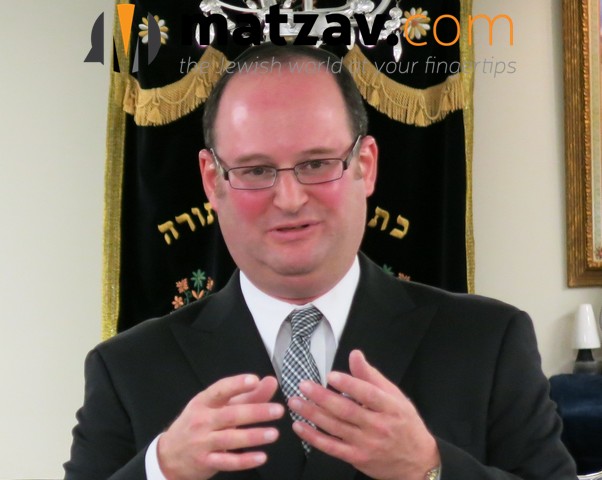
By Rabbi Avrohom Gordimer
The Torah’s presentation of Sukkos in Parshas Emor seems quite mysterious. Let’s take a look.
When introducing each of the Yomim Tovim in Parshas Emor, the Torah states the date of each Yom Tov, then its primary mitzvah, its Issur Melachha (work prohibition), followed by its korbonos. Hence, regarding the 15th of Nissan: “And on the 15th day of this month is the Chag Ha-Matzos (Holiday of Matzos) to Hashem; you shall eat matzos seven days. On the first day will be a holy convocation for you – you may not perform any melachah. And you shall sacrifice to Hashem seven days…” (Vayikra 23:6-8) The same exact pattern appears for Shavuos (whose korbonos are included with the day’s primary mitzvah, which itself is a korban – ibid. v. 16-21), and the pattern continues for Rosh Hashanah (ibid. v. 23-25), as well as for Yom Kippur (whose Issur Melacha, mitzvos and korbonos all appear together, but in a modified order, due to their unique nature – ibid. v. 26-32).
However, regarding Sukkos, we read: “On the 15th of this seventh month will be the Holiday of Sukkos for seven days. On the first day will be a holy convocation – you may not perform any melachah. Seven days shall you sacrifice to Hashem. On the 8th day will be a holy convocation for you, and you shall sacrifice to Hashem – it is a day of cessation; you may not perform any melachah. These are the appointed times of Hashem, which you shall declare…” (ibid. v. 34-37). Then, after summarizing the Yomim Tovim, two pesukim later, the Torah proceeds to put forth the mitzvos of Sukkos: “But on the 15th day of the seventh month, when you harvest the produce of the earth, shall you celebrate the holiday of Hashem for seven days… And you shall take unto yourselves on the first day a beautiful fruit of the tree (esrog)… You shall dwell in sukkos for seven days…” (ibid. v. 39-42)
Why does the Torah totally break its pattern in its presentation of the Yom Tov of Sukkos? Why are the mitzvos of Sukkos wholly separated from the Torah’s main presentation of the holiday?
The Torah itself provides the answer to these questions:
After presenting Rosh Hashanah, the Torah continues: “But on the 10th of this seventh month will be Yom Kippur, it will be a holy convocation for you, and you shall afflict your souls…” (ibid. v. 27) The phrase “this seventh month” indicates that Yom Kippur is an extension of Rosh Hashanah; otherwise, the Torah would have phrased the month more simply as “the” seventh month. “This seventh month” is unusual, and it serves to connect Yom Kippur to Rosh Hashanah, for they share the themes of Din and Teshuvah (Judgment and Repentance). Yom Kippur thus continues the motif and the focus of Rosh Hashanah.
Moving forward a few pesukim, we read, “On the 15th day of this seventh month will be the Holiday of Sukkos for seven days.” Yes, the Torah once again uses the uncanny phrase “this seventh month”, meaning that Sukkos is also viewed as a continuation of Rosh Hashanah, as well as a continuation of Yom Kippur! Hence, Rosh Hashanah, Yom Kippur and Sukkos constitute three links in the same chain.
What is the nature of this chain? The answer consists of two words: Lifnei Hashem (Before Hashem).
On Rosh Hashanah and Yom Kippur, we stand before Hashem, as He, our Father and King, comes close to us, his children and subjects, invites us to present our cases, and draws us near to Him for purification. (V. Rosh Hashanah 16a, 18a, and Yoma 85b.) Sukkos continues this theme, as remain before Hashem, only this time, rather than Hashem coming to us, He invites us to visit and dwell with Him in the sukkah, for the sukkah symbolizes the Beis Ha-Mikdash and the inner sanctums of kedushah (as is clear in Rabbinic and liturgical sources). After the purification of Yom Kippur, we merit access to the locus of the Shechinah, and we accept Hashem’s invitation to enter the sukkah and continue our closeness with Him.
This is why Sukkos features the unique mitzvah of Simchas Beis Ha-Sho’eivah in the Beis Ha-Mikdash (Sukkah 51a), and why the special 7-day long mitzvah of Lulav in the Beis Ha-Mikdash is referenced in the pasuk of “and you shall rejoice before Hashem your God for seven days” (Vayikra 23:40), for we are bidden to enter Hashem’s abode and encounter Him there, continuing the Lifnei Hashem state of Rosh Hashanah and Yom Kippur.
And, getting back to our initial questions, this is why Sukkos is not introduced by its mitzvos, in contrast with the other Yomim Tovim in Parshas Emor, as Sukkos is the continuation of a state of existence that emerges from the combined character of Rosh Hashanah and Yom Kippur. The mitzvos of Sukkos do not come about due to the onset of Sukkos; rather, they are a result of the state of Lifnei Hashem is already manifest as a natural flow from the Yomim Noro’im (High Holidays).
Let us internalize and cherish the experience and privilege of standing in the presence of Hashem and being especially close to Him during this Yom Tov season.
Although we will bid farewell to the sukkah before we know it, we can continue to remain before the Shechinah throughout the year and throughout our lives through learning of Torah, as explained here.
A good Yom Tov to all.
{Matzav.com}











